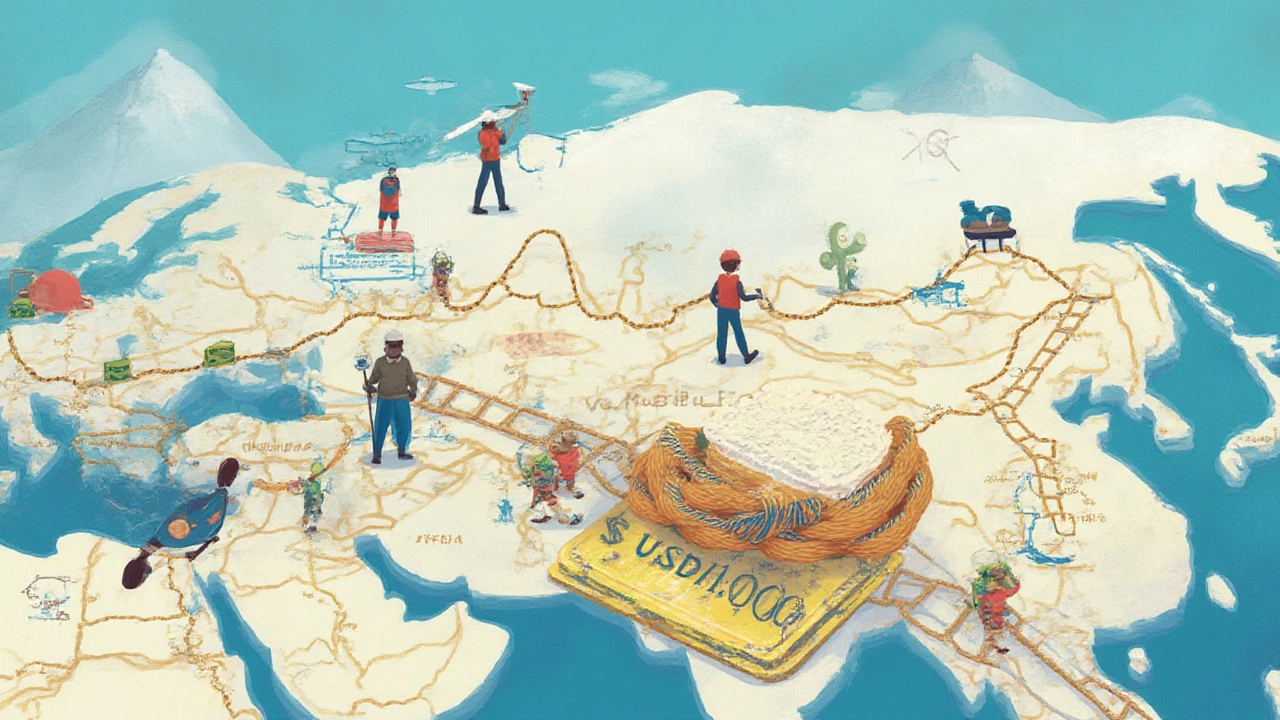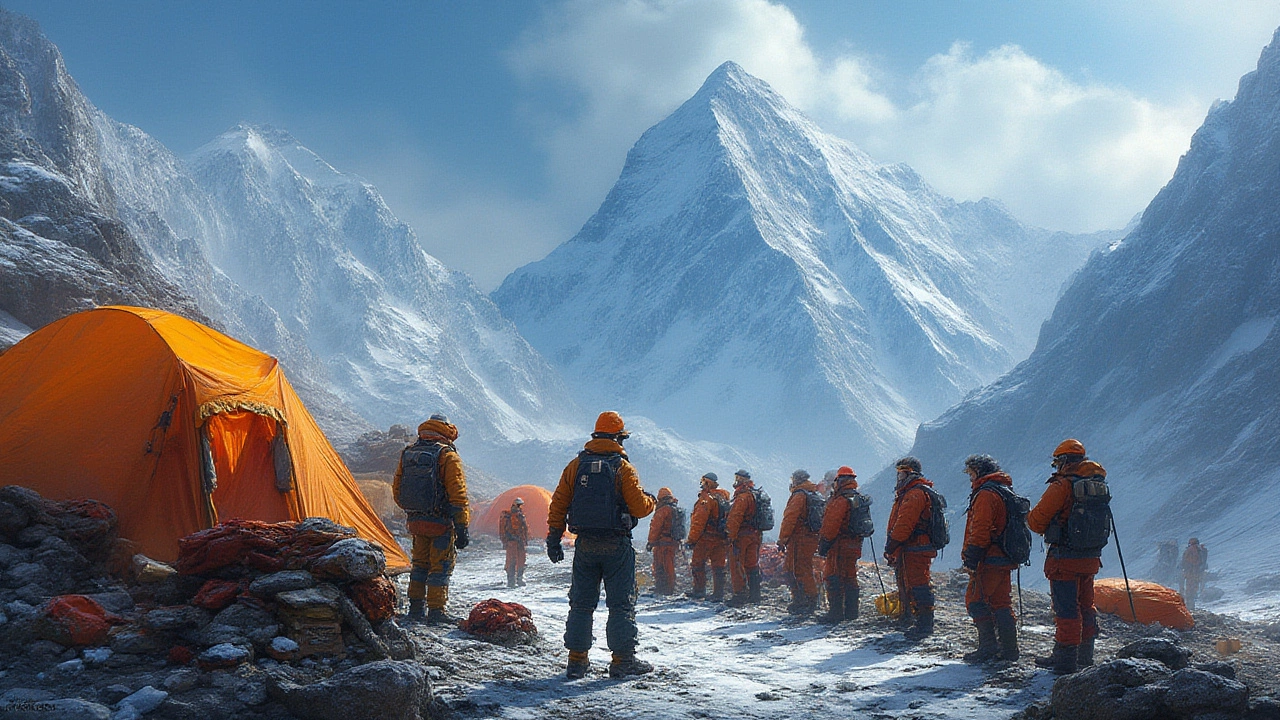Forty thousand dollars. Imagine what you could do with that cash—buy a solid secondhand car, put a hefty deposit on a house in Wellington, or blow it on a year of takeaways and fancy lattes. But for thousands of people every year, that’s just the starting price for a shot at standing on top of the world. Everest has captured the imaginations of adventurers for generations, but the price tag can sound like pure madness. So, what’s really behind that number? It’s not just about a plane ticket to Nepal and some hiking boots—you’re funding one of the most complex human challenges on the planet.
The Price Tag: Where Does $40,000 Go?
When people first hear that tackling Mount Everest can easily set you back $40,000 (sometimes twice that or more!), most think it must be a scam or that someone is lining their pockets. But the reality is far less sinister and a lot more complicated. Here’s the breakdown:
- Permits and Fees: Right out of the gate, the Nepalese government requires each foreign climber to fork over about $11,000 just for a permit. Compare that to a few bucks for Tongariro Crossing here in NZ, and you get a sense of Everest’s scale.
- Guide and Support Team Costs: No, you’re not required to climb alone with a rope and hope. Expeditions need expert guides, mainly Sherpas—the absolute backbone of Everest climbing. A leading guide can cost $5,000 to $10,000, while support Sherpas (who haul gear, set ropes, and even cook) need to be paid too. Their equipment, insurance, and risk come factored in.
- Equipment: Everest chews through gear at a frightening rate. Quality down suits, boots built for minus 40, high-altitude tents, technical climbing gear, sleeping systems, cooking equipment—the shopping list goes on. Expect to drop $6,000 or more if you don’t already have all the technical toys.
- Oxygen: It’s not cheap to breathe at 8,000 meters. One bottle runs about $400-$600, and climbers typically need five to seven. Plus, bottles are heavy, and hauling them up means hiring extra support.
- Food, Logistics, and Base Camp: If you think you’re roughing it with two-minute noodles, you’re wrong. Base camp (your home for weeks) is kitted out with decent food, medical supplies, satellite comms, and sometimes even heating. All those tins of beans, rice sacks, and propane tanks are carried in on the backs of yaks and porters, requiring endless logistical dances. This usually sets you back $4,000-$8,000.
- Insurance and Emergency Evac: High-altitude helicopter rescues? Let’s just say you don’t want to be uninsured. Insurance often adds $500-$1,000 or more, and emergency evacuation alone can drain $10,000 if you need airlifting.
All of this combines into a price that seems impossible—but makes sense once you see the moving parts. And if you want more comfort, fewer risks, or a famous Western guide, the numbers shoot higher and higher.
Climbing Companies: Budget, Standard, and Luxury
Not all Everest expeditions are created equal. Some folks aim for the bare minimum—just a permit, basic gear, and a few Sherpa helpers. Others want comfort, safety, and Instagram-ready yurt tents. Here’s a look at how those choices change the price:
- Budget Expeditions (Around $30,000-$40,000): These cut as many corners as they safely can. You might have a group of unknown climbers, less-experienced guides, fewer oxygen bottles, and barebones meals. If you’re an experienced climber with your own gear and skills, it’s possible, but there’s less margin for error.
- Standard Commercial Packages ($40,000-$65,000): Most climbers choose this route. They get a solid guiding company, several Sherpa guides per client, new tents at each camp, and a reasonable comfort level. There’s more redundancy (spare oxygen, more staff), plus medical checks and cash for emergencies.
- VIP or Luxury Expeditions ($65,000-$130,000): If you want a heated dining capsule, gourmet chefs, individual tents with electric blankets, and possibly even a drone documenting your every step, you’ll pay through the nose. These teams sometimes include private summits with a personal Sherpa, Wi-Fi at every camp, and a Western doctor on call 24/7. Not exactly “Into Thin Air.”
These categories aren’t just marketing. Safety, support, and extras matter a lot at 8,848 meters. Even the toughest Kiwi might appreciate better food and fresh socks when they’re a month into the world’s worst camping trip.

The People Behind Your Summit Bid
Climbers usually get all the glory, but it’s the Sherpa support teams who shoulder most of the real work (and risk). There’s no polite way to say it—without Sherpas, Everest would eat far more climbers alive. Summiting relies on an army of support:
- Sherpa Guides: These aren’t just porters. They climb ahead to fix ropes, ferry up loads (even extra oxygen), and literally dig climbers out of trouble during storms. Most maintain families in the Khumbu Valley, earning livelihoods that hinge on each successful expedition. Their wages have risen, but relative to the risks? Still modest. Expect a $3,000 to $9,000 Sherpa tip at the end of the climb.
- Cooks and Base Camp Crew: Imagine prepping meals for 40 people in a tent at subzero temps. These folks keep climbers fed, healthy, and relatively comfortable during weeks at base camp.
- Porters and Yak Drivers: Every bottle, gas canister, and chunk of camp gear arrives on someone’s back (or a yak). Crossing swing bridges with 50kg sacks at altitude is nobody’s idea of an easy day out. Tips and wages for these workers cost thousands per expedition.
The cost of a safe Everest push relies on compensating these teams fairly—and considering their lives and needs. Ask around the Khumbu and you’ll hear stories of epic rescues, quiet heroism, and a culture deeply interwoven with the mountain. It may explain why experienced climbers, including folks I’ve had a pint with at Mac’s Brewbar, swear loyalty to their Sherpa partners for life.
Hidden Costs, Risks, and Realities
All the pretty sales brochures skip over some of Everest’s more eye-watering “extras.” I’m talking real risks and cash traps no one likes to mention up front:
- Training and Travel: Getting ready to climb Everest isn’t a month on the treadmill. You’ll likely spend years on smaller peaks (Aoraki/Mount Cook or Denali aren’t bad practice). Each trip costs cash—gear, flights, guide fees, insurance—and adds up long before you land in Kathmandu.
- Delays and Weather: You pay for weeks of logistics, not just a summit day. Storm, avalanche, or a late monsoon? Extra nights at base camp, extra food, and sometimes rebooking flights home.
- Health and Altitude: People get sick. Cold, bronchitis, dehydration, frostbite, acute mountain sickness—it’s a cocktail that’s hard to dodge at 5,000 meters and above. Medical treatment at altitude isn’t cheap. If you get airlifted, your wallet will cry.
- Success Rate and Reattempts: Odds of summiting in your first attempt sit around 60%. If weather, illness, or mishap strike, you may come home empty-handed but lighter in the pocket. A second attempt doesn’t get a discount—another $40K is typical.
Climbers often joke that Everest is a game of who can stay healthiest and luckiest, longest. Money gives you more margin, but the mountain still calls the shots.
And here’s a small tip: It pays to scan for hidden fees in your expedition contract. Extra oxygen, a Western guide, helicopter evacuation clauses, gear rentals—even “garbage deposit” fees can surprise first-time climbers. Some Kiwi climbers I’ve met, swearing by lessons learned, rate reading the fine print just as important as training on Ruapehu in whiteout conditions. Sometimes Annie wants to know if these guys are bonkers, but hey, we all need hobbies.
Here’s another quirk: the spring season (April-May) is when everyone aims for the summit window—so prices and traffic peak. Autumn climbs can be cheaper, but weather’s rougher, and success rates dip. Some people wait years for their shot, signing up with a reputable guide—one with a proven record, strong ethics, and transparent pricing.
Everest is not just a rich person’s playground. Climbers save for decades, sell assets, or crowdfund trips. A few have mortgaged homes or cashed out retirements for a shot at the summit. The high price isn’t about luxury—it’s about making sure you come back alive. If that sounds dramatic, so is the mountain. Everest doesn’t care how much you’ve paid, but your chances of seeing another Wellington sunrise sure creep up if you’ve invested wisely in skills, gear, and a rock-solid team.
